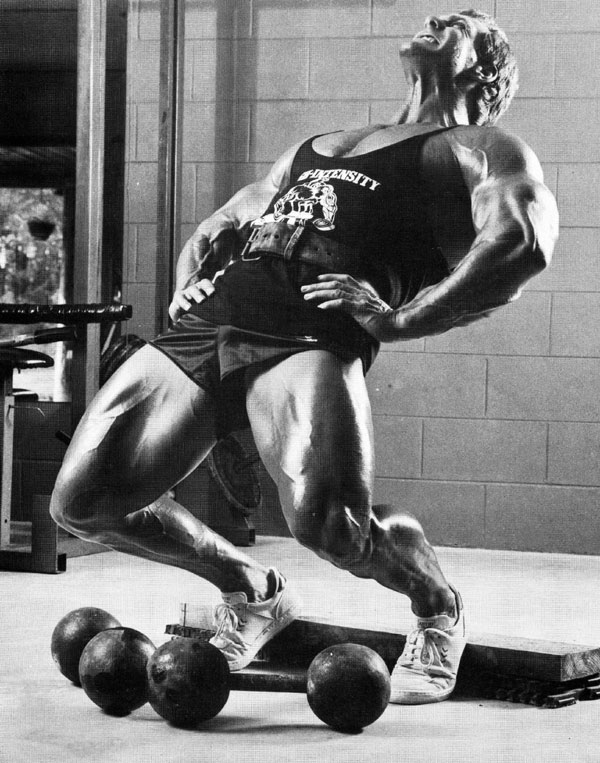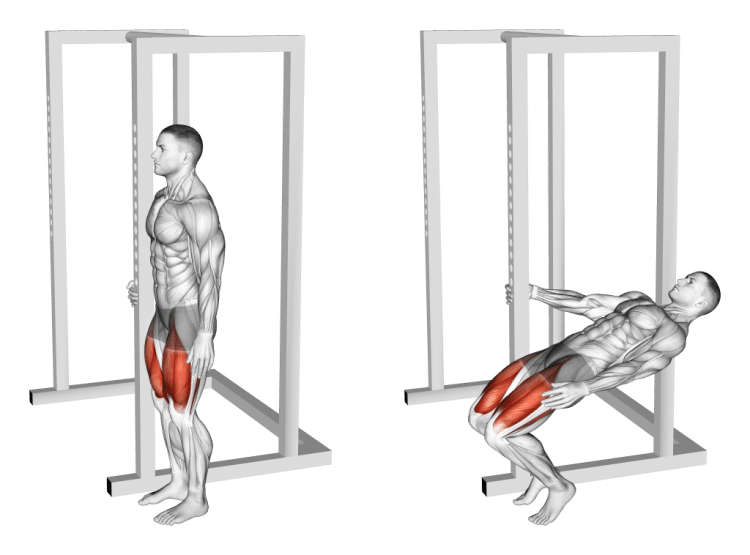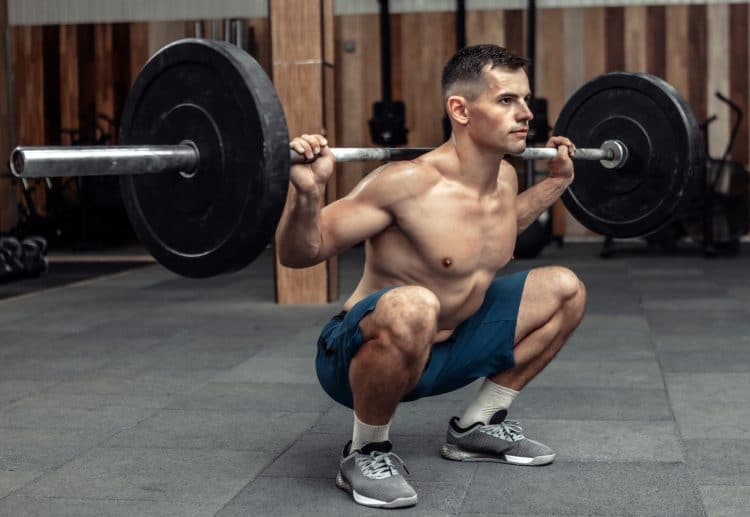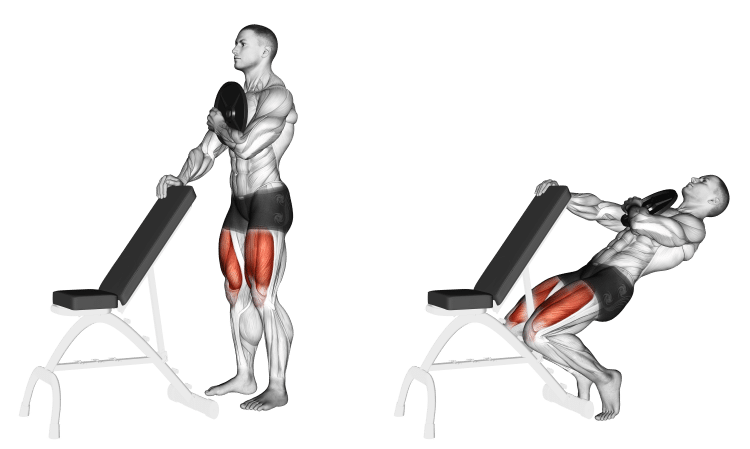We’ve all heard the expression ‘shut up and squat.’ It’s basically telling us to forget all the bro-science and get busy under the heavy iron with the barbell squat. But what if there was a better squat – one that did a more effective job of targeting the quads while reducing spinal compression?
There is – and it’s called the sissy squat.
Yes, it’s an unfortunate name, but don’t let that put you off. The sissy squat could just be the best quad-building exercise you’re not doing.
As a veteran personal trainer, I was introduced to the sissy squat back in the late 80s. So, for more than 30 years, I’ve been programming it into my clients’ leg training workouts. Many of my clients hate it because it’s such a tough exercise – but they love the results!
In this article, we take a deep dive into all things sissy squat. You’re about to discover why it’s so good at isolating the quads, how to program it for maximum results, and whether a bodyweight exercise can really replace the barbell squat.
Let’s dive in.
What is the Sissy Squat?
The sissy squat is a bodyweight variation of the squat that involves leaning back and pushing your knees forward over your toes as you descend. This creates two key differences when compared to the traditional bodyweight squat:
- Your hips remain locked, so there is no hip hinge movement. As a result of leaning back, your torso forms a straight line all the way to your knees.
- Your lower legs descend to close to a horizontal position as your knees track over your toes and come close to the floor.
The leaning back aspect of this exercise makes it difficult to balance. As a result, most people will do the exercise while holding onto a support with one or both hands. In the gym, the ideal support is the frame of a squat or power rack. At home, you can hold onto a wall, door edge, or similar solid upright.
The sissy squat is a surprisingly challenging exercise, especially when compared to a traditional bodyweight squat. That’s because it does a tremendous job of isolating the four quadriceps muscles – especially the vastus medialis, or ‘teardrop’ muscle.
Most beginners will struggle to do ten reps consecutively on this exercise.
Why Do the Sissy Squat?
In the introduction, I made the bold statement that the sissy squat is a more effective quadriceps exercise than the barbell back squat. I realize that, for many gymgoers, that’s like committing muscle-building blasphemy. So, now’s the time to back it up.
Here are four reasons why you should be doing the sissy squat for quad gains:
1. Quad Isolation
The only movement that you do with the sissy squat is to extend your knees. The absence of hip movement takes the glutes, hamstrings, and lower back out of the exercise. That contrasts with the traditional squat, which involves all of those body parts.
As a result, the sissy squat is an isolation rather than a compound exercise. Contrary to popular opinion, isolation moves are more effective muscle and strength builders.
In other words, you are better off doing a quad isolation exercise like sissy squats and then doing a glute isolation move like glute machine kickback than doing a single exercise like back squats that hits each one 30%.
2. Rectus Femoris Engagement
The four muscles that make up your quadriceps are the:
- Vastus intermedius
- Vastus lateralis
- Vastus medialis
- Rectus femoris
The three vastus muscles all originate at the top of the femur (upper leg bone) and insert into the knee joint. However, the rectus femoris originates on the front of the pelvis, crosses the hip, and then inserts into the hip joint alongside the vastus medialis.
As a result of the different origin and insertion points, the rectus femoris acts differently to the other three muscles. While it does contribute to knee extension, which is the only function of the vastus muscles, it is not active when the hip is moving.
A 2016 study compared the rectus femoris activation of single-joint (like the sissy squat) versus multi-joint (like the back squat) exercises. Fifteen men performed leg extensions and leg presses separately at various loads. The results showed that the introduction of hip torque that comes with multi-joint exercise significantly decreases rectus femoris activation. (1)
3. Tibia Angle
Every muscle has a primary lever that is responsible for movement. For the quadriceps, that lever is the tibia or lower leg bone. The more you can load that lever, the more work the muscle has to do.
A lever is least activated when it is parallel with resistance. When it comes to the sissy squat, the resistance is gravity. So, when you are standing in an upright position, there is zero activation of the quads. In this position, your lower legs are parallel to the downward force of gravity.
The more you are able to move the lower leg toward a perpendicular position, the more you’ll be engaging your quads.
Now take a look at this picture of a deep back squat …
Let’s now compare this to a sissy squat …
Notice the angles of the lower leg. With the back squat, it is approximately 60 degrees. Yet, with the sissy squat, it is about 25-degrees.
Remember that at 90 degrees, there is no stress on the quads, and at zero degrees, there is maximum stress on the quads. Clearly, then, the sissy squat does a far better job of activating the quadriceps overall.
4. No Spinal Compression
When you perform a weighted back squat, there is a lot of compressive pressure on the spine. This is the result of the weight on your back. Over time, this can lead to an increased risk of spinal injuries, such as herniated discs and vertebral fractures.
Sissy squats eliminate all that compressive force. Yet, as we’ve seen, there is no reduction in quad activation (in fact, it is just the opposite). That makes the sissy squat a smart choice if you’re weighing up the pros and cons of an exercise.
How To Do the Sissy Squat
- Stand in front of something stable (such as a power rack) and hold onto it with one (or both) hand for balance. Position your feet at a slightly wider than shoulder-width distance apart.
- Lean back as you transfer your weight to the balls of your feet, maintaining a tight core.
- Lean back as far as you can, keeping your abs tight and keeping a straight line from your head to your knees.
- Bend your knees to descend to the floor, allowing your knees to track over your toes. Go down as low as you can. Your heels will come off the floor in the bottom position.
- Push through the balls of your feet to return to a standing position.
Sissy Squat Progression Plan
The sissy squat is not a beginner-friendly exercise. Many people benefit from a progression plan that allows them to advance to more challenging versions of the exercise gradually.
Here’s a five-exercise stepping-stone plan to achieving the perfect sissy squat:
1. Knee Sissy Squat
With this version of the sissy squat, you are able to practice the backward lean from a stable base. Here’s how to do it:
- Kneel on the floor with your knees together and hands clasped in front of your chest.
- Lean your body back without hinging your hips. Aim to achieve a straight line from your head to your knees. Go back as far as you can.
- Pull through your quads to come back to the start position.
2. Wall-Assisted Sissy Squat
While the sissy squat focuses on the lean-back part of the exercise, the wall-assisted sissy squat is all about the lower leg angle. Here’s a step-by-step guide:
- Stand just inside of arm’s length from a wall, facing it.
- Reach out to touch the wall with your fingertips.
- Lift up on your toes and then drive your knees forward without leaning your body back. Try to go all the way down until your tibia is as close to perpendicular as possible.
- Push through the balls of your feet to return to an upright position.
3. Two-Hand Supported Sissy Squat
We now bring the two halves of the movement together with the two-handed supported version of the sissy squat. You’ll need a solid anchor to hold onto, such as a power rack frame. My preferred set-up is to place an unloaded Olympic bar on a squat rack at chest height and grab onto it at a shoulder-width distance.
- Set up your anchor system and stand in front of it. Reach out to grad the anchor with both hands. Your feet should be shoulder-width apart.
- Rise up on your toes and lean back as far as you can. Do not hinge your hips.
- Drop your knees down and forward to go into a squat.
- Push through the balls of your feet to return to the start position.
4. One-Hand Assisted Sissy Squat
Once you feel comfortable with the two-handed assisted squat, you should move on to the one-handed version. This one requires a bit more balance.
- Stand in front of an upright that you can grab onto, such as a power rack frame. Hold the frame with your nearest hand for support.
- Rise onto your toes as you lean back to form a line from your head to your knees. There should be no hip movement.
- Drive your knees forward and down to descend to the floor.
- Push through the balls of your feet to return to the start position.
5. Unassisted Sissy Squat
You are now ready for the unassisted version of this exercise. Perform it as above but without holding onto any support. Only attempt this version of the exercise when your confidence and balance allow you to lean back to a 45-degree unaided and to descend until your lower legs are close to perpendicular.

Read also: The 12 Best Sissy Squat Alternatives
The Pendulum Sissy Squat
The Pendulum sissy squat is a variation of the exercise that allows you to achieve a greater tibia angle without losing your balance. To do this version, you will need a dip belt or a climber’s harness to connect your body to an anchor point. You’ll also need a rope or chain.
Here’s how to do it:
- Secure a dip belt or climber’s harness around your waist. Connect a chain or rope to the belt and connect it to an anchor point at shoulder level.
- Stand with your feet shoulder-width apart and arms by your sides. You should be about two feet away from the anchor point. Using a slant board under your toes will enhance your stability.
- Lean back as far as you can as if you were water skiing.
- Lower as far as you can by bringing your knees forward and down.
- Push through the balls of your feet to return to the start position.
Common Sissy Squat Mistakes
The sissy squat is not a natural exercise. It will feel uncomfortable, and you will probably think that you’re going to fall over backward. Here are some common mistakes that people make with this exercise:
Hip Hinging
Bending at the hips is what we do when we squat; it’s in our programming. So, to do the sissy squat properly, we need to consciously stop ourselves from doing it. The key to the effectiveness of this exercise is to only move from the knee joint. That requires you to lean back as if you are doing the limbo, with no hip hinging.
Unstable Trunk
You need your core to be stable in order to maintain balance and stability when doing the sissy squat. Be sure to squeeze your glutes and abdominals throughout every stage of the movement.
Not Leaning Back Enough
Your goal in this exercise is to create a straight line from your neck to your knees. That means your torso should be at about a 45-degree angle to the floor as you descend. That will maximally activate all four quad muscles and allow your lower leg to get close to the ideal perpendicular position.
Also read: Weighted Sissy Squat
Wrap-Up
It’s easy to dismiss the sissy squat as another easy bodyweight exercise. All you have to do is give it a try to see how misguided that idea is. If quadricep mass is your goal, the sissy squat needs to be part of your program.
I recommend doing three sets of 10-12 reps of sissy squats after your other lower body work. Just don’t expect to be climbing any stairs for a couple of days!
References
Fitness Volt is committed to providing our readers with science-based information. We use only credible and peer-reviewed sources to support the information we share in our articles.
- Ema R, Sakaguchi M, Akagi R, Kawakami Y. Unique activation of the quadriceps femoris during single- and multi-joint exercises. Eur J Appl Physiol. 2016 May;116(5):1031-41. doi: 10.1007/s00421-016-3363-5. Epub 2016 Mar 31. PMID: 27032805.
منبع: https://fitnessvolt.com/sissy-squat-guide/


